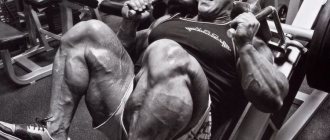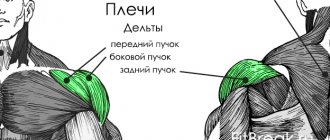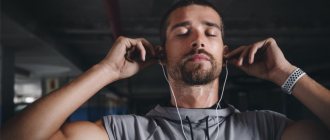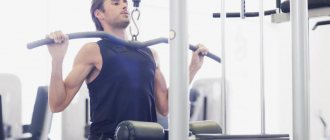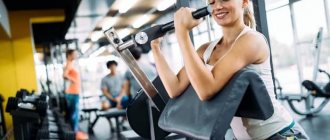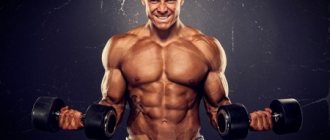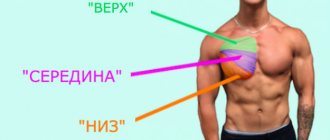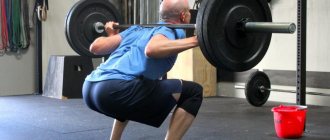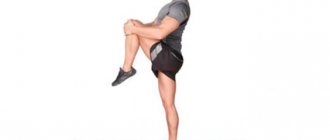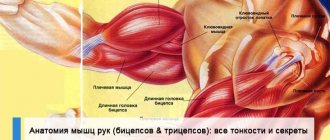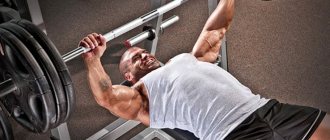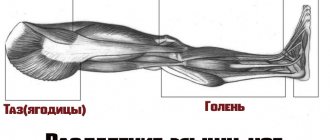The barbell is a classic bodybuilding and strength training tool for gaining muscle mass. Having a barbell and a set of plates allows you to perform many different exercises for all muscle groups of the body - without machines or other equipment.
There are five main multi-joint barbell exercises: squats, deadlifts, bent-over barbell rows, standing barbell presses, and bench presses (the only exercise listed that requires a bench). How to do them correctly - techniques and tips.
Basic exercises[edit | edit code]
Basic exercises
Basic exercises
- this is a type of exercise that involves several muscles or muscle groups; several joints can be involved at once. Typically, these are heavy exercises that are performed with free weights.
Classic basic exercises
- Bench press
- Deadlift
- Squats
Examples of exercises that are also basic:
- Pull-ups
- Bent-over barbell row
- Army press
- Dips
- Lunges
In fitness, the following exercises are considered basic:
- for the deltoid muscles - standing barbell press from the chest, push press, standing barbell or dumbbell row to the chin;
- for biceps and triceps - strength training on the horizontal bar or rings;
- for the back - barbell rows with slightly bent legs (Romanian deadlifts), barbell rows tilted to the waist, lifting a projectile from the floor to the chest, pull-ups on the horizontal bar;
- for legs and buttocks - platform press, hack squat, all variations of “lunges”, deadlifts, “glute bridge”;
- for the abs - full twisting with the body raised, toes raised to the bar while hanging and the “dragon flag”;
- for the chest and triceps - in addition to the bench press in all variants of push-ups from gymnastic loops or rings, push-ups with weights and in “depth” (on supports)
Basic exercises are considered the most effective for muscle growth and increasing strength. Beginners are recommended to build their training program exclusively from basic exercises. Experienced athletes are also not recommended to include more than 20-30% isolation exercises in their program.
In each workout, basic movements must be adequately combined. The principles of creating an optimal program are described in detail in the article Muscle balance and the basics of training
How heavy should the free weight be?
How heavy the weight should be depends entirely on how strong you are, as well as your training history, the number of repetitions planned, and the purpose of the exercise.
However, to choose the right weight for your workout, ask yourself the following questions:
- Will I get enough exercise with this weight?
- Will I be able to complete the entire workout according to the planned list of exercises?
- Will I be able to perform all the reps correctly with this weight?
- Will I be able to complete all exercises with this weight?
- Do I feel that training is a challenge for me?
The ability to understand how and how much you can lift is another key to success.
"Once an exercise becomes easy, change it up," says renowned trainer PT Dalton Wong. – You can increase the weight, do more reps, increase the tempo, or perform the exercise differently. Your body likes to take the path of least resistance, so once it's used to the challenge, it's time to change your training conditions."
The effect of basic exercises on testosterone levels[edit | edit code]
Source
: Strength training and testosterone
The above article discusses the effect of physical exercise in various variations on increasing hormone levels, including testosterone. It contains a very large number of references to research, which allows you to verify the reliability of the information.
General conclusions from the above article regarding the differences between exercises in increasing testosterone levels:
- Data on the effect of physical exercise on testosterone secretion are very contradictory.
- Most of the percentage increase in testosterone levels is due to changes in blood plasma volume (hemoconcentration).
- The increase in testosterone levels has little to do with the type of exercise and depends mainly on the intensity and volume of the workout.
- Training volume has a greater impact on testosterone levels, even when intensity is reduced.
- As such, the increase in testosterone levels resulting from exercise is small and short-lived.
- Long-term changes in testosterone occur the morning after exercise and therefore depend on the outcome of the entire workout, not individual exercises.
In addition to the above, it should be noted that abandoning a complex exercise, such as a deadlift, or replacing it with a simpler one, allows you to achieve greater intensity and volume in the remaining exercises, thus, the resulting increase in testosterone levels will not change.
All these facts allow us to conclude that the importance of exercises such as squats and deadlifts is greatly overestimated. Choosing exercises based on their effect on testosterone levels does not make sense.
You should also reconsider the conclusions of the following text from the journal Iron World 2013 No. 12.
Bodyweight training program: safety precautions
If you ignore some rules, you can get injured. “Warming up at the beginning of training, joint exercises, increasing body temperature, heart rate, and correct exercise technique are required. You should gradually complicate the training, building exercises from simple to complex,” says Elena Chindyaeva.
Pay special attention to the technique of doing the exercises. “Control your movements as much as possible. You must clearly understand what you are doing and how. Avoid completely unfamiliar exercises, adds Edward Kazaryan. - Maintain a long, elongated spine. Do lumbar and neck stabilization exercises.”
Base or insulation[edit | edit code]
BASIC exercises: how to do it CORRECTLY?
Source
: Iron World 2013 No. 12
Even the most notorious neophyte knows that basic exercises are the basis for building a bodybuilder’s training program. When asked why basic exercises are better than isolating exercises, you can usually hear the answer that several muscle groups are involved in the basic exercise, due to which you can lift more weight than in an isolating exercise, which means that the trained muscle receives more training stress; In addition, major changes occur in metabolism. More advanced people answer that when performing basic exercises, a greater release of anabolic hormones occurs. Both opinions equally accurately reflect the essence of the processes occurring in the body under the influence of complex multi-joint exercises.
Base and endogenous hormones[edit | edit code]
Read the main article:
Strength training and testosterone
It has been known for a long time that physical activity causes a hormonal response. Studies have found that one of the main factors contributing to this is the intensity and duration of exercise. That is, not every load causes a hormonal response. In addition, the influence of these factors is modulated by emotional stress. It is assumed that the connection between physical exercise and the activity of the endocrine system is due to the spread of nervous excitation from the motor centers of the brain to the motor neurons of the spinal cord - the so-called. central motor command.
A “stronger” central motor command is associated with greater changes in catecholamines, growth hormone, testosterone and adrenocorticotropic hormone during exercise. The more weight we use in an exercise, the more intense the load and the stronger the central motor command that initiates the hormonal response. However, in parallel with the intensity, the second factor must be observed - the duration of the load. Thus, when using two different exercise programs with a load of 10 and 5 repetitions to failure, changes in testosterone levels in the blood were more significant after performing exercises with a load of 10 repetitions compared to a similar exercise with a load of 5 repetitions [1][2]. These results confirm the thesis that has emerged practically in bodybuilding that progress in working weights is important for muscle growth, and not in maximum ones. Powerlifting is not the best sport for gaining muscle mass. It is quite natural that when performing squats with a barbell, the nervous excitation going from the brain to the spinal cord is stronger than when performing, for example, extensions or flexions of the lower leg, since when squatting it is necessary to activate several large muscle groups at once and move a much larger weight. Therefore, the hormonal response is stronger. By the way, it’s not for nothing that squats are called the most testosterone-rich exercise, since it has also been confirmed that the hormonal response to weight training also depends on the volume of muscles involved in the work. Training a small muscle like the biceps does not cause any hormonal changes. In this matter, the advantage of basic exercises is obvious.
The benefits of isolation exercises[edit | edit code]
What else do basic exercises provide when the goal is hypertrophy of muscle mass? What is the difference between the load on the pectoral muscles when performing bench presses and dumbbell flyes? It's not particularly different. In the bench press, we can use much more weight than in flyes, but not because the pectoral muscles work more efficiently, but because in addition to them, the triceps and anterior deltoids also work intensively. Try doing an isolating triceps exercise before the bench press, 20 repetitions until failure, so that the acidification with lactic acid is stronger, and then immediately do the bench press. See how much weight you use drops noticeably (the main thing is that the bar does not fall on your chest). During the bench press, the pectoral muscles receive exactly as much as is left for them after subtracting the load on the triceps and shoulders, and this figure will be much less than the weight of the barbell. If you look at the factors that arise under the influence of training load, affecting accelerated protein synthesis in muscles, increased concentrations of free creatine and hydrogen ions in muscle fibers, as well as increased concentrations of anabolic hormones in the blood and muscle), it becomes clear that all of them can occur mainly when performing basic exercises (in the correct mode). Isolation exercises are performed using one muscle or muscle group, and therefore the weight used is small, which means that the central motor command that initiates the hormonal response is also small, if not zero. But the increased concentration of free creatine and hydrogen ions in working muscle fibers occurs equally intensely in both isolating and basic exercises. Moreover, in isolation exercises you can achieve even greater concentrations of these substances. When performing, for example, chest curls on a machine, we work only with the pectoral muscles, and when failure occurs, we can rest assured that it is caused by the depletion of creatine phosphate and the accumulation of hydrogen ions in these muscles. When bench pressing a barbell, refusal to perform the exercise can occur due to exhaustion and acidification of the triceps, and at this moment in the pectoral muscles, which we are actually trying to pump up with the bench press, the concentration of free creatine and hydrogen ions has not yet reached the optimally high level. This means that the stimulation of protein synthesis in these muscles will be weak, which can often be found in practice, especially among ordinary amateurs who bench press enormous weights and have underdeveloped chests.
I myself was one of those, squeezing 170 kg for 8 repetitions without difficulty. My pectoral muscles were flat, but my triceps were voluminous, and this was without special exercises for them.
Now imagine that we eliminate the main disadvantage of isolation exercises - weak stimulation of the production of anabolic hormones - by consuming the latter. In this case, with the correct exercise regimen and proper nutrition, we will ensure the occurrence of all the above factors that stimulate protein synthesis.
Then it will be possible to hypertrophy any muscle or muscle group with isolation exercises alone. A very indicative example is the promising St. Petersburg junior Alexei Malysh, who did not train his legs for almost two years due to an injury, and in preparation for the St. Petersburg Championship this fall began to intensively do flexion and extension of the lower leg (he could not fully do basic exercises). At the same time, despite the diet-induced weight loss of 8 kg, the volume of his hips increased by 3 cm in a month. What would happen if he ate the same way as on the “mass”? And remember how many basic, that is, multi-joint, exercises you know for the lower leg muscles? All types of lifts occur in one ankle joint, and other muscles do not work, but this does not prevent you from pumping up muscles of amazing size.
Conclusions[edit | edit code]
What follows from all of the above? In general, what you already know. Basic exercises were, are and will be the main tool for building the body. However, if for a “naturalist” this is the only tool, then for a “chemist” it is “one of.” An artificially created high level of anabolic hormones will allow you to benefit from isolation exercises with equal success, and sometimes even with advantage. Of course, we are unlikely to build a training program only on them. After all, we are athletes and we get a thrill from working with heavy weights in basic exercises. However, if temporary circumstances arise when it is impossible, for example, due to an injury or lack of equipment at a place of rest (business trip), to do a base, then we can replace it with isolating exercises, without fear of losing the acquired form and even progressing further. Unfortunately, “straight” people are in a less advantageous position in this case. Does it make sense for them to do isolation exercises at all, because although they do not stimulate the production of hormones, they also have certain benefits, which were mentioned above? Eat! But only after several basic working approaches have been completed. Then the level of anabolic hormones, which increases after this, will rush through the bloodstream into those muscles that we are working with emphasis.
Bodyweight exercises at home: how to increase the load
It is important to gradually increase the load as the body adapts to it. To do this, according to the advice of Edward Kazaryan, work with the following parameters:
- Number of repetitions . “Increase their number in each approach. In the first week, do 15 repetitions, and in the second, 20, and so on,” says Edward Kazarian.
- Number of approaches. Do not two approaches, but three.
- Duration of rest. “If you are a beginner, first rest 2 minutes between exercises. After a month, reduce the break to one and a half minutes, then to one,” the expert advises.
- Speed of exercises. By performing familiar movements faster, you also increase the intensity. However, remember about safety precautions. “It is important that you make a fast movement as clearly as a slow one. You need to learn this gradually,” adds Edward Kazaryan.
Bodyweight training can also be based on the interval principle, that is, performing exercises for a certain period of time. This method is effective for losing weight. A workout from Jacqueline Wood, a fitness trainer and blogger from the USA, was designed based on this principle. We invite you to try it today.
How to build a lesson
- Start your workout with a light warm-up.
- Perform the exercises consistently for the specified amount of time.
- Finish your workout with stretching.
- Do this program 2-3 times a week.
To complete the complex you only need a mat.
The weak link in the chain
The critical region of the kinematic chain of the shoulder complex is often overloaded. Implementing effective corrective exercise programs will reverse shoulder dysfunction, help you stand out from your competitors, and help you redirect your traffic to build a client base and contacts with healthcare professionals. A good trainer helps a client recover from injury, while a great trainer will recognize dysfunction before it manifests as injury and know how to adjust the program when it does.
Application
Assessment and corrective exercises in the clinic
For a more in-depth understanding of how to safely perform an assessment and develop a corrective program, see the following resources from the IDEA archive (www.ideafit.com/fitness-products):
- The Fundamentals of Structural Assessment, by Justin Price, MA (DVD)
- Shouldering the Load From the Ground Up, by Chuck Wolf, MS (CEC course and DVD)
- Designing a Self Myofascial Release Program, by Justin Price, MA (CEC course)
- Corrective Exercise for Shoulder Impairments, by Eric Beard, MS (CEC course)
- Six Steps to Better Program Design, by Michol Dalcourt (CEC course and DVD)
Source:
IDEA Fitness Journal, Issue 10, Number 10
Exercise therapy of the lumbar region according to the method of Bubnovsky and Evdokimenko
Sergey Bubnovsky is a rehabilitation specialist by profession, the author of a large number of exercise therapy complexes for joints, recognized by official medicine.
Pavel Evdokimenko is a rheumatologist, a member of the highest level of the Academy of Medical Sciences of the Russian Federation. Among his works are a huge number of books that describe recommendations for the treatment of arthritis and arthrosis.
Doctors Bubnovsky and Evdokimenko developed an effective set of exercises. You can familiarize yourself with the technique of their implementation, which will make physical therapy of the lumbar spine more effective, in the video.
- Lying on your stomach, reach your buttocks with your heel, bending your legs one at a time. The head is turned in the opposite direction. Hold the position for 10 seconds. After this, relax for a few seconds and repeat the movement again.
- I. p. - on all fours. Arch your back and hold this for five seconds. After that, relax. Performing the exercise from the side resembles the behavior of a cat on its hind legs, which is why it has a similar name.
- I. p. - lying on your back. First pull one leg towards your stomach, then the other. Help with your hands. Tighten your muscles for seven seconds and then relax.
- I. p. - lying on your back. Wrap your arms around your legs and pull them towards your stomach. Tighten the muscle tissue for 10 seconds, then relax.
- I. p. - sitting on a chair. Bend over slowly. Your task is to thoroughly stretch your back. As you inhale, tighten your lower back muscles for six to seven seconds, and as you exhale, relax.
Video instructions for exercise therapy of the lumbar spine:
.
Nowadays, you no longer have to spend a lot of time performing complex and unpleasant procedures at home. It is much easier to seek help from real professionals - the Veronika Herba beauty and health center, equipped with effective and modern equipment.
Why clients choose Veronika Herba beauty and health center:
- This is a beauty center where you can take a course of exercise therapy for the lumbar region at a reasonable cost, and you will be treated not by an ordinary cosmetologist, but by one of the best specialists in Moscow. This is a completely different, higher level of service!
- You can receive qualified help at any time convenient for you. The beauty center is open from 9:00 to 21:00, seven days a week. The main thing is to agree with your doctor in advance on the date and time of your appointment.
Sign up for a consultation with a specialist by phone +7 (495) 085-15-13, and you will see for yourself!
Single-joint movements
Also called isolated movements, these exercises focus on movement in one joint.
Examples:
biceps curls, leg extensions, leg curls and almost all exercises performed on machines. If the purpose of the exercise is to “work” a specific muscle group (for example, the middle deltoid or the short head of the biceps), these are single-joint movements.
How to prepare for lumbar exercise therapy
Physical therapy may be prescribed by a doctor after the results of the examination. Don't forget about the rules that will help you make it effective:
- The best time for classes is before lunch. The last meal should take place 1.5 hours before they start.
- Every workout should start with a warm-up. It helps warm up muscles and ligaments, prepares the heart for stress.
- During the exercise, use a roller under your knees at the correct height (the thigh and shin are perpendicular to each other).
- Record the exercises you perform in your diary and monitor the results.
For osteochondrosis, there is a whole complex of gymnastics. Exercises vary in difficulty and stages. Follow the lesson plan without combining them with each other.
The lumbar exercise therapy program is divided into blocks that are intended for a specific stage.
The first stage is carrying out exercise therapy in the acute period . As simple and slow movements as possible.
The second stage is the subacute period . If the pain has decreased, you can increase the load, but gradually.
The third stage is remission . The pain has stopped, complex exercises are included.
Choose loose clothing that will not interfere with your workout. We recommend paying attention to a cotton T-shirt or tank top, shorts or sweatpants. If you exercise outside in cold weather, use woolen items.
Inventory you will need:
- Gymnastic ball.
- Swedish wall.
- Pillow for the knees.
- Fitness mat.
5-minute exercise therapy for the lumbar region
- Lying on your stomach, legs straight, bend your arms at the elbows and press them to your body. Lean on your straight arms and lift your upper body off the floor. Turn your head first in one direction, then in the other. Return to the starting position and relax. Do 2-3 repetitions.
- Lying on your stomach, stretch your arms forward. Legs remain straight. Raise your torso while simultaneously performing a crawl motion with your arms. Repeat 4-6 times.
- Similar to the previous exercise, move your arms using the breaststroke technique. Do 4-6 reps on each arm.
- I. p. - lying on your stomach, hands pressed to your chin. Crawl on your bellies. The movement involves pulling the knee towards the elbow. Repeat 4-6 times.
- The situation is similar to that described above. Lift one of your straight legs up, point your toes down. Repeat the exercise with the other leg. Do 4-6 times.
- Raise your arms and legs at the same time. Hold this position and after a few seconds return to the starting position. Relax. Do 3-4 repetitions.
Shoulder Anatomy: Passive Systems
The shoulder is more than a single joint. The complete kinematic chain runs “from nose to toes” and it is impossible to list all the relationships in this case. However, when we look at the shoulder we will include some of its broad connections to other parts of the body.
The human movement system includes the actions of the joint, nervous and muscular systems (Clark & Lucett, 2010). In what follows, we will call the articular system, including bones, joints and ligaments, the “passive” system, and the muscular system the “active” system.
The passive system provides fulcrum, support, and leverage for the muscular system. The main bones of the shoulder girdle include the humerus, scapula and clavicle. The shoulder girdle complex interacts with the rib cage, thoracic and cervical spine. The lumbar region and pelvis can also be included due to muscular and fascial connections. When the passive system is asymmetrical, it can result in shortening of the active system, causing decreased performance, reduced endurance, and increased risk of injury (Travell & Simons, 1983).
The joints most closely associated with the work of the shoulder are the humerus (HL), acromioclavicular (AC), sternoclavicular (SC) and scapulothoracic (SL) joints. An in-depth description of these joints is beyond the scope of this article, but personal trainers should thoroughly research these joints before creating programs for clients.
The LH joint is classified as a false joint due to the lack of direct interaction between the bones. The scapula simply glides across the surface of the chest, however, the significance of these movements to shoulder function warrants their inclusion in the review. The intercostal and costovertebral joints associated with the thoracic spine can influence local and general musculature (Epstein et al. 1993). Despite their small size, these joints are an integral part of the chest.
When the bones are in perfect alignment, a full range of motion is possible at the joints. For example, flexion, abduction, adduction, internal and external rotation, and circumduction will be possible in the shoulder joint. This joint is extremely mobile and can provide a large range of motion. High mobility is accompanied by a low level of stability. The scapulothoracic muscles help slow down the movement when throwing, acting as a kind of anchor: the chest in relation to the scapula, and the scapula in relation to the humerus through the glenoid fossa.
The scapula is a kind of platform for the humerus. If the scapula is in the correct position, the humerus follows (Sahrmann, 2001). The scapula is capable of ascending, descending, moving forward and backward (protraction and retraction), and rotating outward and inward. Also sometimes referred to as forward and backward deviation of the scapula. The acromion process of the scapula is connected to the clavicle by the AC joint.
The acromion is the wide, ridge-like end of the bone and can have three shapes. Type 1 - flat, type 2 - curved, type 3 - hooked - which determines the amount of free space for the rotator cuff, biceps tendon and joint capsule. Anomalies of the acromion are congenital and no corrective exercises will create more free space. Type 3 uncinate acromion is associated with the highest incidence of rotator cuff injuries (62%) and impingement (30%) (Epstein et al. 1993).
The correct position and functionality of the HA and AC joints can be difficult to assess. Maintaining their delicate interaction promotes shoulder health and function. If you suspect their function is impaired, contact a licensed physician for evaluation (Lee, 2003).
Normalizing the position and function of the thoracic region is often forgotten. In people who move extremely little during the day, the thoracic spine is often excessively flexed and extension and rotation are limited. A posture that increases thoracic kyphosis reduces the effectiveness of the scapular stabilizers and rotator cuff muscles (Clark & Lucett, 2010). Violation of the position of the shoulder blades is a sufficient basis for analyzing and assessing the mobility of the thoracic region.
The structure of the ligamentous apparatus of the shoulder girdle is of particular interest. Ligaments are not only flat, straight formations that provide static support to joints. They can twist like a rope.
Closer to the limit of the range of motion, ligament tension and support from the joint capsule increases to prevent damage. Ligaments also contribute to proprioception, providing the nervous system with valuable feedback about joint position and tension (Osar, 2012).
Cartilage provides a smooth surface for joint interactions. Disturbances in the kinematics of joints and bones wear down this tissue over time. The destruction of cartilage is immediately followed by pain and inflammation.
The subacromial, subdeltoid and other bursae reduce friction in the shoulder joint. The subacromial bursa most often becomes inflamed after repeated impingement between the humerus and acromion.
Repeated stress destroys active systems faster than passive ones. If a client is experiencing pain as a result of a passive system injury, the movement disorder is likely to have appeared somewhat earlier. The functions of the active system are much more easily disrupted. Tendenitis will immediately appear with poor posture and repeated incorrect movements.
Gentle physical therapy exercises for osteochondrosis of the lumbar spine
1. Lying on your back.
- Hands at your sides, legs together. As you inhale, pull your arms up, and as you exhale, lower them. Number of repetitions – 4-5.
- Bend and straighten your feet while clenching and unclenching your fists. Do it 10 times.
- Rotate your feet in a circle. In each direction 4-6 times.
- Pull your knees to your chest one at a time. Do 6-8 reps.
- Move your right arm and leg to the side, for example. Repeat in the same way for the left limbs. Do 4-6 repetitions.
- Clasp your fingers in a “lock” at the back of your head. Raise your head while pulling your toes towards you. Number of repetitions – 8.
- Hands at your sides. As you inhale, stretch your arms up, while simultaneously pulling your toes in the opposite direction from you.
- Place your legs bent at the knee joint, shoulder-width apart. Use your knee to touch the opposite foot, and vice versa. Do 4-6 times.
- Exercise “bicycle”, simulating pedaling. Repeat five circles back and forth.
- Place your hand on your stomach. Take a deep breath into your belly and then exhale slowly. Number of repetitions – 3-4.
- Stretch your left hand along your body, and stretch your right hand up. Repeat the exercise, changing the position of your hands. Do 10–12 times.
- Spread your arms to the sides, feet shoulder-width apart. With your left hand, reach your right hand. Repeat the exercise for opposite limbs. Number of repetitions – 6–10.
- Pull your knees towards your chest with your hands. First the left knee, then return to the starting position and repeat the exercise with the right. Do 6-8 times.
2. Exercise therapy lying on your side.
- Swing your arm and leg upward. Repeat about five times.
- Pull your knees to your chest: 6-8 reps.
- Swing your leg forward and backward. Repeat 6-8 times.
Perform the exercises in the same way, lying on the other side.
3. Exercises while standing on all fours.
- First move one hand to the side, then the other. Do 10–12 reps.
- Swing your leg back, straightening it. Repeat with the other leg. The quantity for each is 8–10.
- Pull your left knee towards your right hand. Repeat, switching sides of limbs. Do 6-8 times.
- Pull one knee toward your chest. After this, take your leg back, the toe should slide along the floor. At the same time as this movement, you need to sit on the opposite heel. Perform the exercise in the same way with the other leg.
- Swing your straight leg up and back. At the same time, pull your opposite hand up. Repeat similarly for the other leg and arm. Do 6-8 times.
- The legs are fixed in one position, and move your hands to the right and left sides. Repeat five times in each direction.
- Without lifting your hands from the floor, try to sit on your heels. The exercise is performed slowly. Do 6-8 times.
- Without lifting your hands from the floor, sit first on your left buttock and then on your right. Repeat 6-8 times.
- Place your hands on the floor and raise your head. Arms straight. Lower your head to your chest and arch your back, then arch it back. Make movements at a slow pace. Number of repetitions – 8–10.
